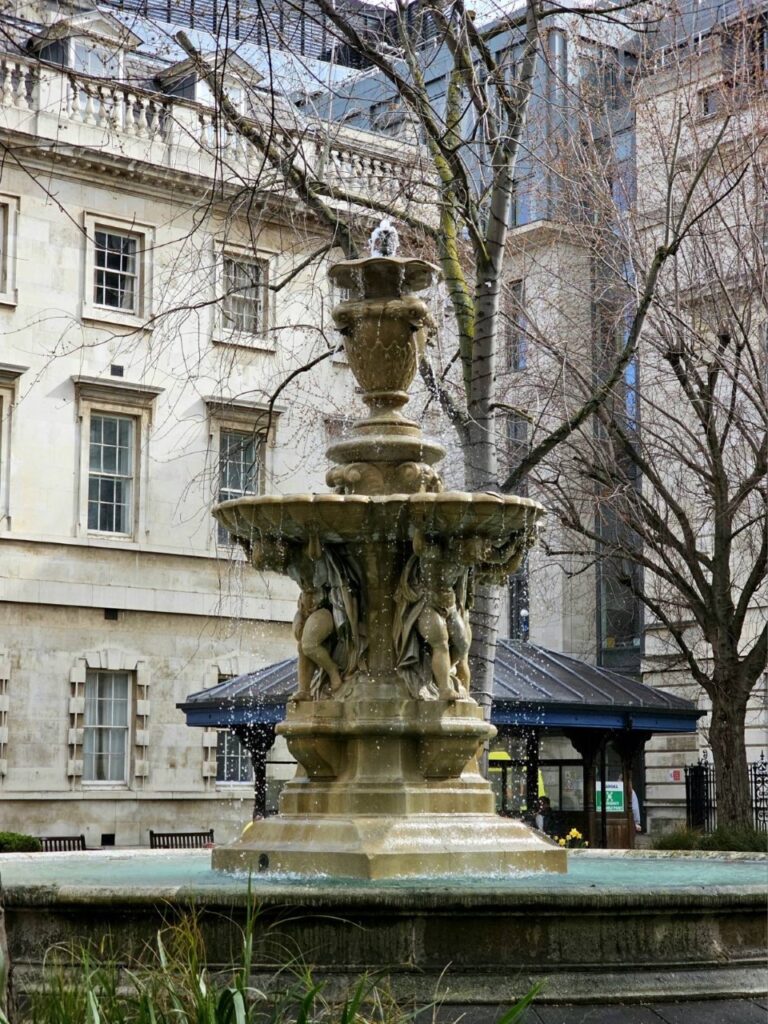Aaroh Dubey
London, England
 |
| St. Bart’s quadrangle fountain. Photo by author. |
“What’s in a name?” Juliet asks the audience in Act 2 Scene 2 of Romeo and Juliet. The play laments the folly of holding onto the past and giving undue meaning to names and titles.1 Outside of Shakespeare, however, things are rarely as black and white: names are important, the past shapes our future, and history matters. St. Bartholomew’s Hospital and its affiliated medical school have a profound and storied history. Their history and name matter.
Though the year is unknown, the story goes that while on a pilgrimage to Rome, the monk Rahere, a favorite of King Henry I, took ill. During his bedrest, he was reputedly visited by an apparition of St. Bartholomew who charged him with a holy duty to establish a religious hospital.2 Whether this may have been a result of delirium or even a first episode of psychosis, Rahere answered this call and went on to establish St. Bartholomew’s Hospital in London in 1123. Also known as “Barts” today, it is the oldest hospital in Britain.
During the plague-ridden times of the fourteenth century, St. Bartholomew’s truly proved its mettle. In the face of death and destruction, the hospital stood tall, with the brave staff offering succor and care to the sick and dying.3 One figure who rose to prominence during this time was the physician John Mirfield, who treated countless patients afflicted with the Black Death. His unwavering spirit and selfless devotion to patients earned him the nickname “Angel Doctor.” This tradition continued with figures such as Florence Nightingale and Edith Cavell, who honed their skills within Bart’s hallowed halls.4 Nightingale, the “Lady with the Lamp,” tended to wounded soldiers during the Crimean War and is known for her pioneering work in modern nursing.5 Cavell, a nurse who trained at the hospital, became a symbol of courage and compassion during World War I when she was executed by the Germans for aiding the escape of over 200 Allied soldiers.
St. Bartholomew’s has also been home to some of the most famous names in medicine. William Harvey,6 the father of modern anatomy, studied and taught at the hospital, making ground-breaking discoveries about the human circulatory system. He was followed by Timothy Bright, who is credited with being the first person to publish a psychiatric text in 1586 titled A Treatise of Melancholie.7 In more recent times, St. Bartholomew’s Hospital has continued to blaze a trail with the development of life-saving treatments, such as being the first hospital to offer mega-voltage radiotherapy for cancer patients in the UK7 and the pioneering use of robots in surgical procedures.8
The courage, sacrifice, and selflessness of the figures who have graced its corridors are a testament to the enduring spirit of humanity and a reminder of the healing power of love and compassion. St. Bartholomew’s Hospital is not just a name, but a legacy that will hopefully continue to inspire and guide generations to come.
It has not all been smooth sailing, however. The 1992 Tomlinson Report, though controversial, stated that London had too many hospitals and recommended the closure of St. Bartholomew’s in its entirety.9 In response, patients, nurses, and doctors organized the “Save Bart’s” campaign with the slogan: “Save Bart’s today, it could save your life tomorrow.” The historical and practical importance of the hospital was understood, not just in the immediate care it provided to the sick and infirm, but also that the name of Bart’s was synonymous with pioneering medical discovery and invention.
We who are students at the medical school are proud of being part of Bart’s past and future. We take pride in training at the meeting place of Sherlock Holmes and Dr. Watson, in walking the same halls as Sir William Harvey, and in being a small part of this history. It spurs us on through long lecture days and nights of study in the library as we strive to be worthy of the Bart’s name.
References
- No Sweat Shakespeare. “‘What’s In a Name?’ Soliloquy Analysis.” 2011. https://nosweatshakespeare.com/quotes/soliloquies/whats-in-a-name/.
- Encyclopaedia Britannica. “Saint Bartholomew’s Hospital.” 1999. https://britannica.com/topic/Saint-Bartholomews-Hospital.
- Thornbury W. “St Bartholomew’s Hospital.” In: Thornbury W, Old and New London: Volume 2, London: 1878; 359-363. Available from: British History Online, https://british-history.ac.uk/old-new-london/vol2/pp359-363.
- van Alfen P. “The Meaning of a Memory: The Case of Edith Cavell and the Lusitania in Post-World War I Belgium.” American Numismatic Society Magazine, Spring 2006. Available from: Internet Archive, https://web.archive.org/web/20130607045402/http://ansmagazine.com/Spring06/Cavell. Accessed March 14, 2023.
- Longfellow HW. “Santa Filomena.” The Atlantic, 1857. https://theatlantic.com/magazine/archive/1857/11/santa-filomena/531180/.
- French R. “Harvey, William (1578–1657), physician and discoverer of the circulation of the blood.” Oxford Dictionary of National Biography, September 23, 2004.
- “History: 20th Century.” Barts Heritage, 2022. https://bartsheritage.org.uk/history/20th-century/.
- Gardner A. “One Hundred Patients Benefit from Robotic Surgery at St Bartholomew’s hospital.” Barts Health NHS Trust, August 7, 2018. https://www.bartshealth.nhs.uk/news/one-hundred-patients-benefit-from-robotic-surgery-at-st-bartholomews-hospital-3948.
- Tomlinson B. Cited in: British Medical Journal, “Tomlinson report recommends London closures and mergers,” October 31, 1992;305(6861):1045-50.
AAROH DUBEY is a fourth-year medical student at Barts and The London Medical School in the UK. He plans to pursue critical care medicine after graduation.
Spring 2023 | Sections | Hospitals of Note

Leave a Reply